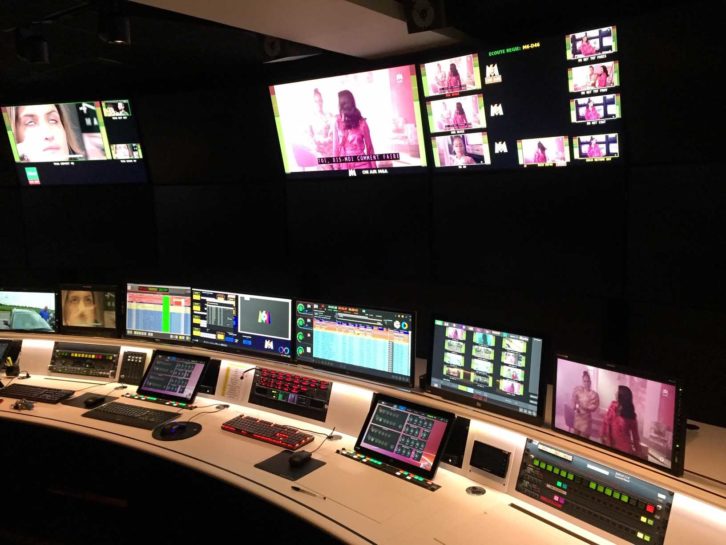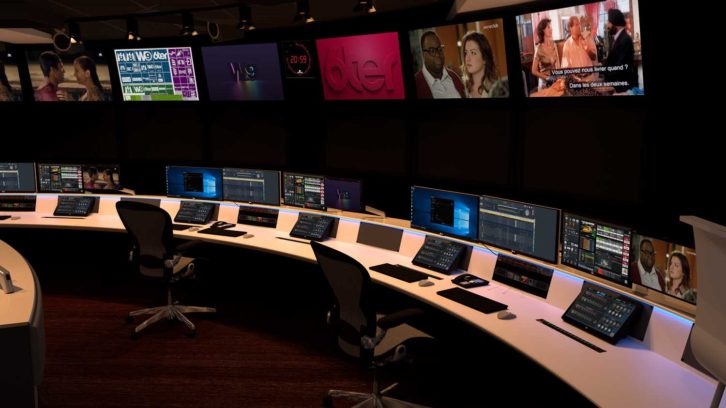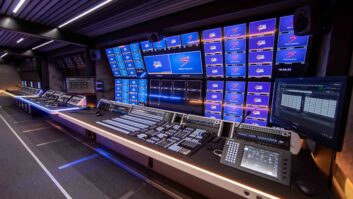Leading French broadcaster Metropole Television SA (commonly known as the M6 Group) has futureproofed its new Master Control Room near Paris by placing state of the art Evertz IP technology at the heart of its operation. The switch from SDI to IP (ST 2110) will allow M6 to easily incorporate new HD services, new delivery platforms and new video formats such as Ultra HD 4K and 8K.
Based in Neuilly sur Seine, M6 is the most profitable private national French TV channel and the third most watched television network in the French-speaking world. Its new Master Control Room now hosts playout for 11 channels including the broadcaster’s premium M6 channel and other popular channels such as W9, Série Club, 6TER, TEVA, Paris Premiere, M6 Music and M6 International.
The decision to build a new MCR was taken in 2018 when the M6 engineering team, headed by technical manager Franck Martin, recognised that the old SDI facility had been in place for more than 10 years and was reaching the end of its viable life. Most of the equipment no longer had manufacturer support and, in addition, M6 needed the flexibility to add more channels, reflecting the fact that it is a vibrant and expanding company.
“We had to imagine how M6 might look in 10 to 15 years’ time and build a technical facility that could deliver on its long-term goals,” says Martin. “That meant creating space for new channels and embracing new technologies. It would have been simpler to rebuild in SDI because everyone understands that format, but after much debate we decided to switch to IP technology because it will be much quicker and easier to add more channels as and when we need them, and offer UHD channels in the future.
“Alongside technological development, we also wanted to improve the monitoring and ergonomics of our playout centre. We chose Evertz VUE software for this as it allows us to manage our video wall to turn on the screens when alarms are triggered. The black screen is less tiring for our technicians and its ignition on alarm attracts more attention, compared to a permanently lit wall. Also, VUE displays video sources and allows switching directly on a touchscreen for easy operation.”
Most broadcasters would agree that switching to IP is a logical next step for the industry but making the transition still requires a significant leap of faith because the technology is so new and revolutionary. Finding a way to successfully meet this challenge was crucial for M6, and the main reason why the broadcaster chose Canadian company Evertz as its technology partner.
“We chose Evertz for two main reasons,” explains Martin. “Firstly, we knew the company and the quality of its products because our previous SDI router was an Evertz EQX. Secondly, and perhaps more importantly, we recognised that Evertz had both the expertise and the technology to help us manage our transition to IP. We knew it would be a steep learning curve and we wanted a partner that would work closely with us so that they understood our workflow and how we like to operate.”
At the heart of M6’s new television playout Master Control Room is Evertz EXE-VSR IP switch fabric, which provides 46Tb/s of switching capacity and delivers exceptional flexibility and scalability for video transport over IP. Using SMPTE ST-2110, EXE supports up to 13,800 uncompressed HD-SDI signals – and many more when compression technology such as JPEG-2000, H.264, or MPEG-2 is utilised.
The system installed comprises 11 sections – one for each channel path and all with similar sets of equipment. Common to each section is an advanced multi-image display processor with customisable next generation Evertz image processing technology; an Evertz evBLADE offering high density FPGA processing nodes for audio, video and ancillary data processing; a high density Evertz IP media gateway offering conversion between SDI and all common IP formats; an Evertz advanced clean switch to protect the integrity of output video, even when faced with a catastrophic error and an Evertz ST 2110 to HDMI converter. Each slot also includes third party equipment (controlled over NMOS IS-04/05) such as Harmonic media servers, Ross Video graphics engines, an Aeromax audioprocessor system and an SCTE104 inserter.

Each section is built around a central Evertz system that includes the EXE-VSR main and redundant IP switches, two Evertz MAGNUM controllers, two VistaLINK PRO servers for end to end network management and Evertz 5700MSC-IP Network Grand Master Clock and Video Master Clock. The entire system is linked to eight VUE software defined interfaces that allows operators to visualise, control and get immediate feedback on all the equipment in the facility in a simple, effective and user friendly way.
Delivering a project of this magnitude required careful planning. Franck Martin and Fabrice Tauzies, chief engineer for the playout centre, spent two weeks at Evertz headquarters in Canada for in-depth demonstrations of the new technology. They also visited other Evertz customers such as HBO and AMC (New Jersey) to see working systems that have already been installed.
“It was a steep learning curve, and we had a lot of issues to overcome, particularly with software versions that needed to be refined and improved and integration with third party manufacturers,” says Martin. “Also, the way Europeans work is very different to Canadian and US broadcasters. We don’t have just one person doing one job because it is too expensive. We have fewer operators and tighter budgets, and we need to optimise our resource management. Plus, our standards are very high – it is like comparing Haute Couture with high street fashion. It took Evertz a while to understand this, but once they did, they were fantastic and incredibly scrupulous.”
Tauzies adds that having local support in France was another key factor in the decision to go with Evertz. “We specified this before we signed the order because, in France, we prefer to work with people face to face,” he says.
Frédéric Loup, Evertz field service manager for France, fulfilled this role and was able to translate M6’s requirements to the Evertz technical team, making the entire process much smoother.
“It was a pleasure working with M6 on this project and the feedback they gave us, particularly about the operational elements of the Evertz system, was so useful,” Loup says. “We used this project as an opportunity to improve our equipment and I truly believe that M6 is now a great European reference for Evertz IP technology.”
Work on the new MCR began in 2019 with the first cable installed in April. However, various external factors – including the Covid-19 pandemic and subsequent lockdown – delayed the project and it took until September of this year for all the channels to migrate over to the new system.
“We built the new MCR in the same location as the old one, so we faced some practical issues with regard to space,” Tauzies explains. “Obviously, we couldn’t simply shut down and strip out the old MCR because that was still handling playout for all our channels, so we had to work around it. It was a challenge, but we took our time because we wanted to do it properly and we were not in a hurry.”

One rack was already available in the old MCR but three more were required for the new equipment, and this is where the space issue became a problem because there physically wasn’t room to install new ones. M6 technical staff got round the issue by working in stages. Firstly, they swapped out their Harmonic NAS media grid, which freed up three existing racks, then they moved some existing servers around so that the racks were in the right location. Finally, they installed the EXE, MAGNUM and VistaLINK servers in two of these three racks. The remaining free racks were used for the first two channel path sections – one for the Serie Club channel and one as a backup slot (Secours2).
As soon as Serie Club had migrated to the new system and was up and running, M6 staff were able to move legacy equipment and use the rack space that was created for the next two sections. From there, it was a rolling progression with each channel creating space for the next channel as it migrated to the new system.
“With our old system, each channel required two racks, but the new equipment is much more compact, and we now only need one rack per channel,” Tauzies says. “This means we have plenty of room to expand when M6 decides to add more channels in the future.”
Despite its complexity, Martin and Tauzies say they are delighted with the end result. All the channels are now working perfectly and although IP still occasionally presents challenges, both men feel that the learning curve has been hugely valuable.
“We learn something new every day,” Tauzies says. “IP may be the technology we are using now but it doesn’t change the way we technical operators work. It is not our job to be IT experts and we don’t need to manage what goes on inside the equipment or understand everything about how the system works internally – we just need to be able to operate it. Evertz made sure that the technology was completely transparent from an operator’s point of view and we are especially happy with the VUE interface, which allows us to do everything we need to do. Normally an ST 2110 solution would require IP specialists to operate it but we don’t have any specialists here. We just have VUE to translate IP systems into operator systems. Our workflow is now much faster, and we definitely think this is the way forward for IP broadcasting.”
Evertz is also delighted with the success of this project, which has now given it a strong reference for its IP technology in Europe. Robert Peter, the company’s VP International Operations, says: “We are pleased to continue our relationship with the management and engineering group of M6 as they use Evertz IP technology in their upgrade and transformation project. As this was one of the larger IP / ST 2110 installations in Europe, we were able to work closely with M6 in all stages of the project from solution and design to the deployment and training. We are very excited to continue to provide local support for the deployment of remaining channels and participation in any future M6 projects.”
Having a solution that can be used for future projects was always M6’s plan, and there is now talk of building a second backup IP playout facility although this is still some way off in the future.
“We have made a big investment and we need to get used to what we have before we build anything else, but we now have a roadmap and any future system will be much easier to implement,” Martin concludes. “Having an IP based MCR has already brought great benefits in terms of future channel expansion and format expansion with UHD and we are very happy with what we have achieved.”






